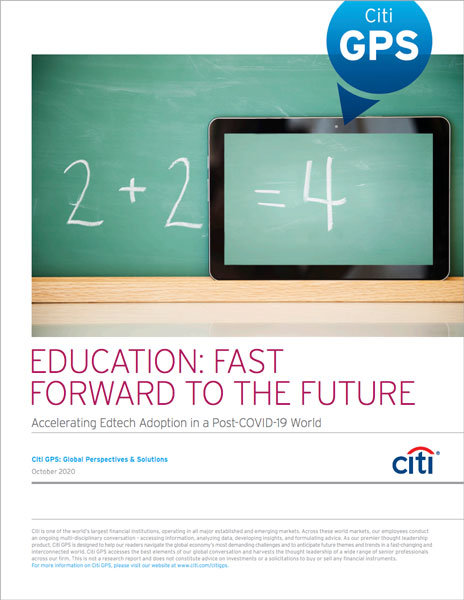COVID has highlighted some of the many issues in education across the world. In many ways, although inequality of access to education is the biggest barrier we face to fairness, one of the most surprising of the issues highlighted was the developed world’s unpreparedness for remote learning.
After many years of edtech innovation, and even with movements such as flipped and blended learning, developed countries were still struggling to put strategies in place to reach their students. Even the developed world wasn’t prepared.
So as we look at the data, stories and lessons that have emerged so far during this crisis, what do we know now that can help us navigate future challenges?
Historic issues
 Education as a sector has been slow to adopt the technologies that have, in many ways, transformed the way other industries work. Citi Bank’s recent edtech report found that spending on edtech accounts for just 3% of overall education spending. And why is this, when technology has revolutionised so many other sectors?
Education as a sector has been slow to adopt the technologies that have, in many ways, transformed the way other industries work. Citi Bank’s recent edtech report found that spending on edtech accounts for just 3% of overall education spending. And why is this, when technology has revolutionised so many other sectors?
Citi Bank’s report says that, for the most part, it is “because of inertia: a sense either that it’s not affordable, it’s not worth it, it doesn’t fit with certain political/ philosophical beliefs, or it’s simply not how it has always been done.” When education is so important, it seems odd that we do not have the same appetite for transforming it as we do other sectors.
In this respect, the pandemic has brought us to a milestone in edtech. It has forced the adoption of technologies that help teachers and schools reach and engage students remotely but perhaps more importantly, it has created an environment ripe for change. There is no time for inertia now.
Changing attitudes
Technology that increases access to education during a pandemic is the same technology that can help reach more children when the pandemic is over. Why then would we undo what we’ve worked to put in place over recent months? Online learning isn’t going anywhere. Infrastructure will continue to be an issue in many emerging markets (it’s still an issue in parts of the UK and US!) but more is being done to address this now. Because of the pandemic, and the resulting lockdowns, we can no longer safely believe that we don’t need edtech.
This is also borne out in Citi’s report. A survey of educators revealed that one-third of respondents had underinvested in edtech due to budget constraints, the aforementioned inertia (where’s the rush, we might have thought, because who would have predicted this year?) or “pushback” from teachers and parents. Now, over 80% of respondents intend to increase technology investments within the next 5 years.
Laser-focus
But it’s not all about attitude towards edtech. It’s also about the tech itself. The pandemic has focused our attention somewhat, and the edtech conversation isn’t about the smartest AI, the wearable tech or the hardware tools that can transform learning (providing you have the budget). It’s about tools that help us reach, engage, assess and support students. The ‘real’ stuff that teachers need, and want, to do.
Citi Bank’s report found that education institutions expect around 50% of all daily study hours will be digitized within the next 3 years. The survey was conducted across more than 700 institutions in eight countries; Australia, Canada, the US and the UK, along with Brazil, China, India and South Africa. The report forecasts that edtech spend will double by 2024 but the biggest appetite for investment is in emerging markets. Developed markets such as Australia and the UK can expect to see around 10% growth; emerging markets will see around 25%.
The figures around online studying are also interesting, especially when you drill down into detail. In the K-12 education market, China expects over 60% of studying to be online, while in the UK the figure is closer to 40%. There’s an obvious reason for this; addressing unequal access to education is an issue in every country but markets such Brazil, China and India often lack the infrastructure necessary to reach all young learners, especially those in remote communities. Technology as a leveller, on a massive scale.
Generational shift
The generational divide when it comes to how tech is seen in the report is also fascinating. Perhaps unsurprisingly, millennials are more likely to consider online education for their child (66% and 61% for males and females, respectively, versus 52% and 47% for non-millennial men and women). But another change we see coming is in the attitude towards where learning takes place. That’s the one with the most potential, in our view.
We’ve talked about the convergence of home and school for a while now but, up until this year, we thought of this in terms of blended or flipped learning. Extending traditional education beyond the walls of the classroom and enabling children to learn wherever they are. In January this year, that felt to us like the best possible approach for education. As we draw towards November it feels like the only approach that makes sense.
Why would we limit learning to school, especially when there is a chance that children won’t be able to physically attend school? Is it really so important to us that our children learn in much the same way we did, often in rows with the teacher at the front (a method in use for the past 100 years)? If asked, back in the early 1900s, most people would expect 2020 to be a radically different world from the one they lived in back then, so why are we (largely) using the same style of education they did? Whether it’s inertia, budgetary constraints or lack of appetite to change, we can’t afford not to address this now.
The world is a classroom
We’re teachers (and parents) and we’ve long talked about topics like unleashing learning.
So that it can take place anytime and anywhere, and the power of learning through play. We see the importance of these topics when we teach and we see it when we spend time with our children. And, like most, we’ve spent a lot more time with our children than usual this year. Learning shouldn’t be relegated to a set timeframe each day, not when technology can make it easier to learn anywhere. It’s worth noting that learning anywhere doesn’t rely on technology; you can learn with anything if you really want to, but technology allows us to record progress, set tasks and create games that lead to good educational outcomes. It’s tech that enables us to do certain things very quickly, freeing up more of our time (something that teachers rarely have enough of).
If teachers want to personalise education for each of their students, creating an individual curriculum for each child is time-consuming. It’s why we created an app for that (plus virtual classroom, teacher dashboard with real-time learner insights and a fully tested language curriculum, of course, but that’s not how the expression goes).
There are certain areas of education that will never change. We will always need teachers, we will always need to assess (although how we do this will be a hotly debated area for quite some time). But do we need to do these things in the same way our parents and grandparents teachers did them? Not if edtech does what it’s supposed to, no. So let’s work together to make sure it does.


